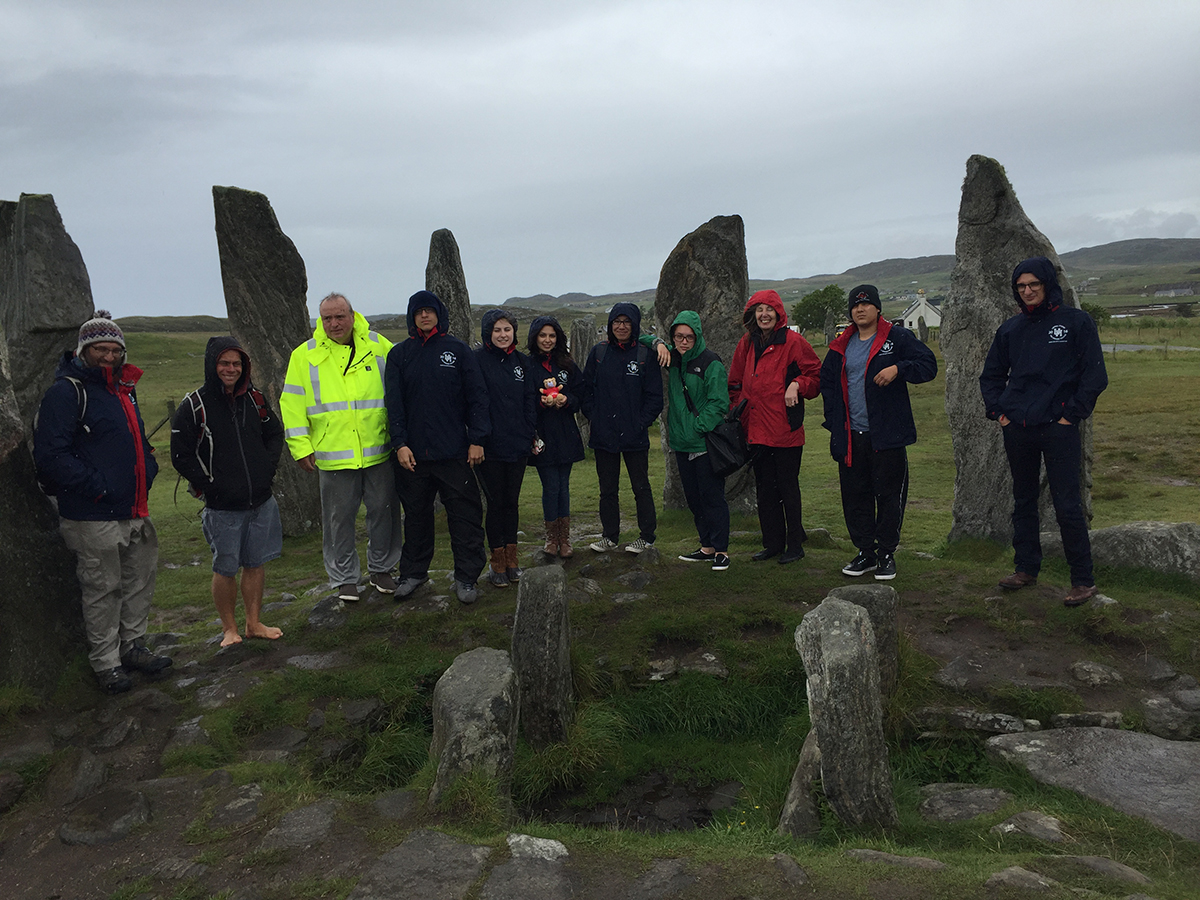
Pictured at Callanish are Dr. Eric Bittner, Dr. Thomas Behr, Yosely Ruiz, Kevin Serpas,
John-Paul Behr, Megan Sweeney, Branly Oliva, Alexandria Doxakis, Julie Nguyen, and
Wylde Swan 1st Mate Tsjerk Hesling Hoekstra .
When Alexandria Doxakis learned about a unique new study abroad opportunity offered through CLASS’s Liberal Studies program, she was one of the first to jump on board – both literally and figuratively.
Doxakis, a senior majoring in creative writing, was one of 11 CLASS students to participate in UH’s first “study at sea” program which was designed and facilitated by Dr. Thomas Behr, director of the Liberal Studies Program.
“I didn't think much about the actual sailing when I was signing up for the trip. I looked at the list of places we would visit and at the price and decided based on those factors,” says Doxakis. “Of course the physical act of sailing demands so much immediate attention, it affects your entire being while on board a ship. You do everything a little differently than you would on land, even pouring a glass of water!”
From July 20 until August 20, participating students and faculty sailed aboard the world’s largest Topsail Schooner, the Wylde Swan, living and working alongside the ship’s full-time crew. Their planned itinerary took them from France to Norway, with several stops in between. However, one of the first things the student-sailors learned is that when you are traveling on a large sailing ship, the wind and weather – not your well thought out itinerary - determines where you go.
“Northerly headwinds forced us to change our route almost immediately,” says Dr. Behr. “We started out in Brest, France and made it to our first destination of Dublin, Ireland. However, after leaving Dublin we went to several islands in the Hebrides and then the Orkney Islands, which were not on our original agenda.”
Missed stops included St. Kilda (Scotland) and the Faroe Islands (Denmark), but those were replaced with visits to the Scottish islands of Iona, Lewis, and Islay as well as a visit to the Isle of Man, a small sovereign nation located between England and Ireland. The journey ended in Bergen, Norway.
“I discovered the true meaning of going where the wind takes you!” says Doxakis.
While on board, students learned from the ship’s crew how to operate the vessel. In addition, everyone had to participate in ‘watch duty’ because although the ship was equipped with radar, it was important for someone to have their eyes on the ocean 24-hours a day in case there was an obstacle in the waters that modern technology did not detect, and always be ready to help hoist or trim sails as wind conditions changed.
“A very romantic notion, if not an altogether accurate one, of sailing involves a lot of standing at the railing of a ship and looking out at the horizon,” says Doxakis. “While there is time for this on a tall ship, there’s always something else you could be doing...there are sails to raise or take down and ropes to coil and decks to scrub and dishes to wash and meals to cook and toilets and tables and floors and walls and showers to clean and there is always something that needs to be fixed.”
Plus, the students were enrolled in a course, which means there is school work to be done.
“This experience was offered as a senior seminar in Liberal Studies,” says Dr. Behr. “Students had to make time to read and write. However, I also believe that Liberal Studies is more than learning through books – it involves exploring the world. In fact, the theme of the course readings was ‘voyages and self-discovery.’”
As an added bonus, their travel package included a personal development curriculum that correlated with their coursework. A job coach/therapist held daily sessions with students under the theme of self-awareness.
As he planned this experience, Dr. Behr really wanted to cut students off from the electronic distractions of everyday life. Sailing in the ocean succeeded in keeping them away from their phones, tablets and other devices—at least until they arrived to a destination and were able to “plug back in”.
At each stop, students explored their surroundings, met the local people, tasted local food, and learned the history of their surroundings. A favorite stop was Callanish, known as the Scottish Stonehenge.
“Those stones had been there for thousands of years, since the stone age,” he says. “During the entire journey we saw so much natural beauty that cameras simply can’t capture.”
Dr. Behr hopes to offer a similar experience to students next summer because he believes this study and sail experience – and the resulting personal growth - should be available to students in the years to come.
When Doxakis thinks about her future, she agrees with Dr. Behr’s assessment of the experience. As she prepared to leave the ship and return to Houston she reflected on her experience by saying, “I am leaving, if not better, then different. I am leaving with the certainty that this has been my first trip aboard the Wylde Swan, but not nearly my last. I am leaving with the hope that the same is true for the University of Houston.”
- Monica Byars